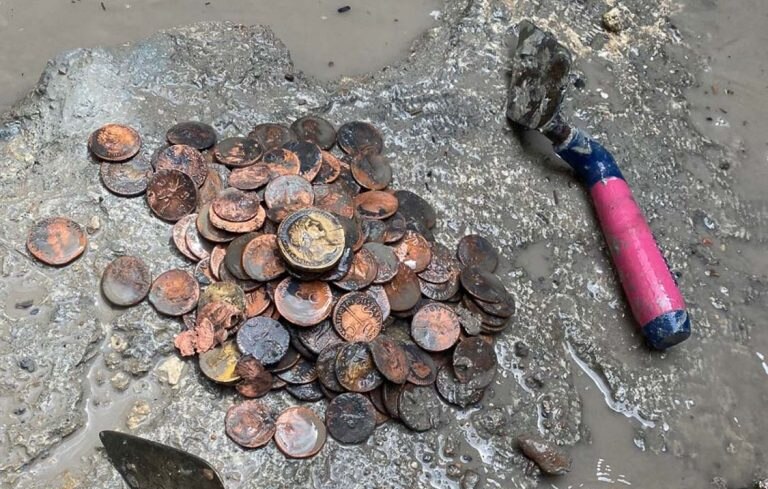Archaeologists have unearthed an extraordinary treasure trove consisting of Etruscan and Roman artifacts in the village of San Casciano dei Bagni, Tuscany, Italy.
Famous for its numerous springs of sulfurous waters spread throughout its territory, the San Casciano dei Bagni village has long attracted visitors from all over Europe.

Credit: Emanuele Mariotti/SABAP-SI
“The Etruscans were the first to build structures for thermal waters, however, it was under the domination of the Romans, true devotees of thermal baths, that the healing properties of these waters gained their huge appeal, as evidenced by the presence of numerous archaeological finds in the area.” 1
The Etruscans settled in a region of Central Italy known as Etruria. They were one of the most influential civilizations in ancient Italy before the rise of the Romans.
“Although these ancient people were much closer to us in time, they were even more enigmatic and inaccessible than other ancient cultures such as Crete, Mesopotamia, or Mycenae, and scientists still have much to learn about them.” 2
The Etruscan and Roman sanctuary of the Bagno Grande in San Casciano dei Bagni “is a geothermal hub with forty hot springs, six connected to the thermal sanctuary. The Etruscan picked this location to utilize the therapeutic power of the water’s chemical properties — it is rich in minerals such as calcium and magnesium, as well as chloride and sulfates.

A collection of three ear-shaped votive offerings unearthed at San Casciano dei Bagni. Credit: Emanuele Mariotti/SABAP-SI
Archaeologists at the site unearthed last week a treasure trove of artifacts and relics, shedding light into the intimate connection Italy’s past civilizations had with “water religion,” or the healing, divine origins of hot spring water.”
Archaeologists have been excavating at the site for a long time and their work has been rewarding.
Rare items believed to have been used as votive offerings to the gods, including so-called fertility statuettes shaped like a phallus, a womb and a pair of breasts — have been dug out from the site’s mud. So have 3,000 ancient coins, 700 of which are freshly minted and still shiny. In the second century AD, Roman emperor Marcus Aurelius Carus had the coins thrown into the baths to honor gods watching over his health, as well as that of all Romans traveling to San Casciano for thermal treatment.

“What makes this site unique in the entire Mediterranean is the exceptional state of preservation, and the [evidence] it provides for how medical hot water practices were considered curative under divine protection,” said archaeologist Jacopo Tabolli, scientific director of the excavation project and professor of Etruscan studies at Siena’s University for Foreigners. “The amount and quality of the objects recovered are also astonishing. We knew something was down there but weren’t expecting such a surprise.
Archaeologists have also discovered many relics sculpted in the shape of miniature bronze legs, arms and ears. These ancient objects were “left to thank the gods for healing specific body parts, or to call attention – hence the ear shape — to the prayers of mortals in pain.” 3
During Etruscan and Roman times, womb-shaped votive offerings were usually made with terracotta. A bronze one found at San Casciano — which would have been very expensive to commission — is the first of its kind, said Tabolli, and serves as proof of how important this thermal site was.
“The discoveries tell us a lot about Italy’s ancient communities,” Tabolli explained to CNN, “and advance our research on their social, cultural and religious landscape with regard to the sacred nature of hot water.”
The excavation site currently features one Etruscan pool, eleven meters long and five meters deep known as the “big bath,” and five smaller Roman pools where hot water still flows in at a pace of some 2,000 gallons per minute. There are ruins of fountains and statues alongside travertine stone altars to the god of prophecy and medicine, Apollo, the goddess of fertility, Isis, and the goddess of the first born, Fortuna Primigenia.
An example of a phallus-shaped offering. Credit: Emanuele Mariotti/SABAP-SI
The number of bronze, silver, orichalcum coins, a precious metal believed by the Romans to have mystical powers found in the big bath, is also extraordinary, said Tabolli. It is the largest collection of ancient currency associated with hot springs in the Mediterranean and is unique for its perfect state of preservation. The coins have retained their original coloring thanks to the water’s chemical properties and being blanketed by mud, which prevented oxidation.
“They’re still shiny brown and shiny yellow — such bright colors have never been found in any excavation site,” said Tabolli. “It’s a miracle.”
A new village museum will soon showcase the recovered wonders to the public. Local authorities and experts believe the spa still holds more treasures waiting to be discovered, with its deepest muddy layers hiding items dating back to the Etruscan era.
Archaeologists will keep working at the site, with Tabolli excited about what might next come to light. “I hope to unearth the founding sanctuary in its entirety,” Tabolli said. “We can already spot a pre-Roman layer.”v

 SAD NEWS: Just 1 Hour Ago in New York, Mark Zuckerberg’s Family Confirmed the Unthinkable — “After a Long Battle With a Terrible Disease, Our Son…
SAD NEWS: Just 1 Hour Ago in New York, Mark Zuckerberg’s Family Confirmed the Unthinkable — “After a Long Battle With a Terrible Disease, Our Son… 
 EXCLUSIVA MUNDIAL | Vivian Wilson, hija transgénero de Elon Musk, rompe en llanto en una entrevista devastadora: “Mi padre es solo un niño pobre con demasiado…
EXCLUSIVA MUNDIAL | Vivian Wilson, hija transgénero de Elon Musk, rompe en llanto en una entrevista devastadora: “Mi padre es solo un niño pobre con demasiado… 


